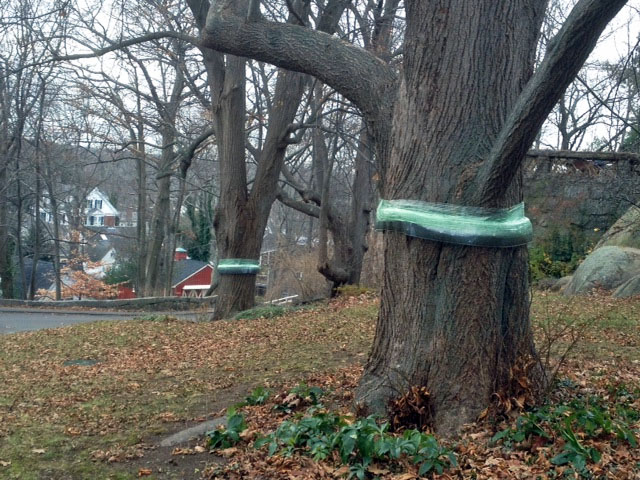
Why these trees are wearing saran wrapped belts around their middles? Annisquam resident, Liz Dooley, submitted photo and wants to know. I’m curious too.
E.J. Lefavour
Spread The GMG Love By Sharing With These Buttons:
Related
Published by God's Morning
I pray you are blessed, built up in your faith and Christian walk, and become an interactive participant in God's Morning. We are here as Christ's body, supporting and building each other up in all righteousness, in His name, awaiting His soon return. Maranatha!
View all posts by God's Morning
EJ I believe that this sticky “saran wrap like” material helps to prevent a bug infestation…someone explained the process in detail to me once, but I am at a loss to recall the information for you. I suggest that you contact an arborist for the specifics. Hopefully, this will set you in the proper direction.
LikeLike
Sure, I know the answer..it’s to protect the trees from moth larvae in the spring. Those litle suckers climb up and denude the tree of leaves….under the plastic is a sticky substance which traps them.
Believe the most often trees to be hit are the oaks.
Don’t hold me to this but it’s the answer I got not long ago.
LikeLike
Gypsy moths. They’ve been a problem for at least a century.
LikeLike
Hi Fred,
I thought that too, but have just read two references to “winter moths” who are breeding now, and their larvae are those inch worms that swing down from their “silk”….in the spring and early summer.
LikeLike
I think we need Kim Smith to chime in on this. Kim – any knowledge on Cape Ann tree killers? Hi Cynthia!
LikeLike
Hi Fred and All,
Winter moths were first introduced to North America in the 1930s by way of Nova Scotia. They have since spread throughout the coastal United States and are particularly destructive to all oak, apple, crabapple, ash, fringetree and blueberry. It is also known to drop from trees and feed on perennials and roses.
I have found the best form of prevention in the battle against winter moths is a horticultural oil spray that I make myself from household ingredients.
The most comprehensive information on winter moths can be found at the UMass Extension website: http://extension.umass.edu/landscape/fact-sheets/winter-moth-identification-management
The following is the section on physical barriers, but I recommend everyone read the entire article because year after year of denuding will most likely result in the death of a tree.
4. Physical Barriers: For years, sticky products have been available for wrapping around tree trunks to (ostensibly, at least) prevent such pests as gypsy moth, fall cankerworm and winter moth caterpillars, as well as the wingless adult females, from climbing up trees. Initially, the product consisted of a band that was wrapped or placed around the trunk of a tree and then coated with a Tanglefoot™-type product, which is remarkably sticky. In small infestations and with limited trees to protect, this may or may not be beneficial overall; the research is still not complete. Newer products now consist of a fiber-batting band (about one inch thick) that wraps around the tree trunk. A plastic, doublewide band that is only sticky on one side is placed sticky-side inward around the batting, and being double-wide, half of it hangs down below the batting and held out away from the tree (see Fig_18) As wingless female moths race up the trunks and encounter the bands, they attempt to climb over the bands and become stuck on the sticky plastic band. In high population years (outbreak proportion),females and attracted males can both become stuck to the band and saturate it within hours. Newly arriving females can then walk over the bodies of the stuck ones and gain access to the rest of the tree. These bands are also marketed to prevent caterpillars from climbing up trees in the spring. However, caterpillars, due to their ability to balloon, can blow from one treetop into another thus by-passing the trunk bands. These bands are not recommended as a management tool when population numbers are high.
LikeLike
Thanks Cynthia and Toby. I thought it had to do with freezing or a wound on the tree, but that makes sense.
LikeLike
They are designed to inhibit the female “winter moth” from climbing the tree and depositing her eggs that will then hatch into the larva that denuded the trees. Apparently the female will only climb the tree. I happened to walk by when the owner of the property was outside and asked him what the wrapping was for. The above was his explanation.
LikeLike
It’s winter moths, whose favorite food is the Norway (or any other ) maple. They manage to eat the leaves just as they come out and can kill a good size tree in a couple of seasons. Hence the wrapping and spraying, which also helps.
LikeLike
Winter moth was correct. We have a particularly bad infestation in Gloucester and our trees have been defoliated over the past 6-8 years. The females cannot fly so the sticky tape collects them before they can breed with the flying males. We think it has helped a little. It would be more effective if you had a single tree, but across the road is a wooded area. We are anxiously awaiting the arrival of the fly (Cyzenis albicans) which will hopefully be introduced by biologist Jeff Boettner of UMass-Amherst this spring. The fly lays its eggs in the larvae and kills it but typically takes a few years after introduction to take a toll on the moth population. Until then we will be enjoying a view of Lobster Cove that we only used to have in the Winter.
– co-owner of trees in question
LikeLike